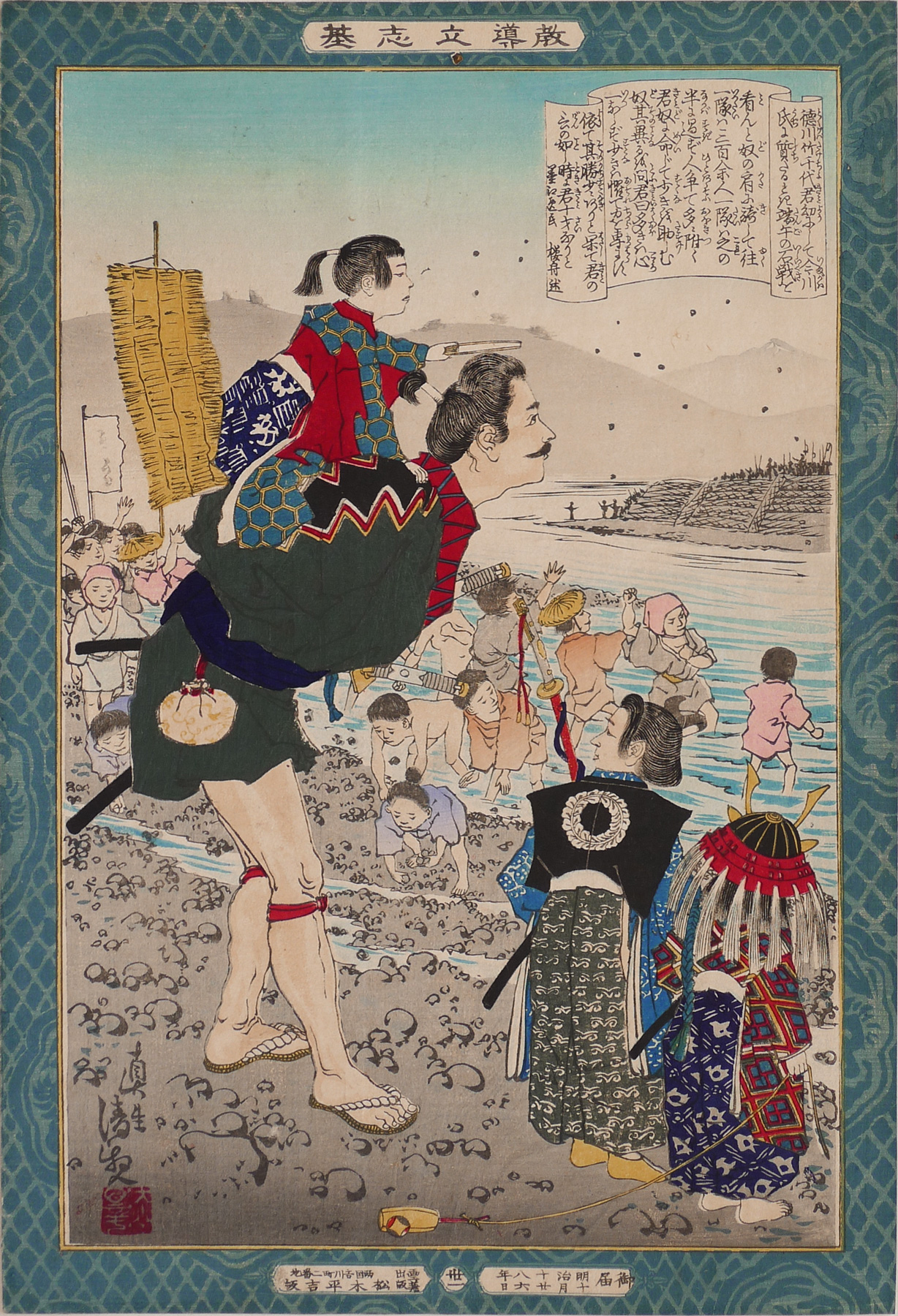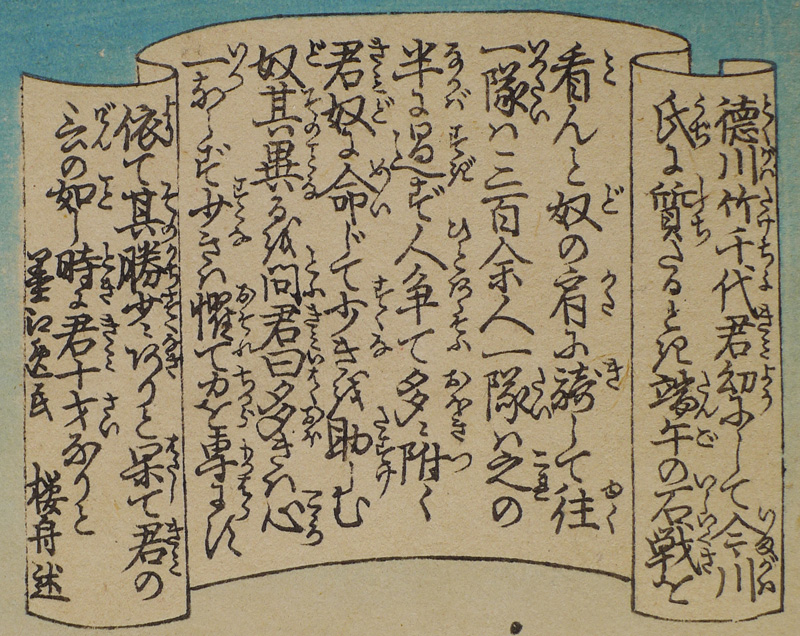About This Print
Print number 卅一 (31)1 in the series Instructive Models of Lofty Ambition picturing ten year old Tokugawa Takechiyo (1543-1916), later to become Tokugawa Ieyasu, founder of the Tokugawa Shogunate, on the back of his retainer, seemingly directing other children throwing stones.Kiyochika contributed 20 prints to this series. As Smith states: "The style of Kiyochika’s offerings toInstructive Models of Lofty Ambition was decorous and even stiff, as befitted the didactic emphasis of the whole [series.]"2
1 Numbering of the prints was haphazard during the production of the series. Print numbers were sometimes inadvertently omitted; some prints in the series were never assigned numbers and a few of the same numbers appear on different prints.
2 Kiyochika Artist of Meiji Japan, Henry D. Smith II, Santa Barbara Museum of Art, 1988, p. 74.
Tokugawa Takechiyo - A Precocious Ieyasu
Source: The Eyes of Power: Art and Early Tokugawa Authority, Karen M. Gerhart, University Of Hawai'i Press, 1999. P. 122.Tokugawa Takechiyo, 1543-1616, (later known as Tokugawa Ieyasu, the founder of the Tokugawa Shogunate) is shown on the back of his retainer, seemingly directing a mock battle of children throwing stones along the banks of the Anegawa. Rocks can be seen in mid-flight. The original anecdote behind this print has the ten year old Ieyasu not directing the battle, but rather commenting on the battle, to the effect that the more organized and motivated, although smaller, group would win.
On arriving, he said to those in attendance, “Don’t watch the majority side. It’s best to be on the other side.”
This was then seen as an indication of the young Ieyasu’s precocious wisdom and prowess in battle, and evidence of “a divine gift with which Ieyasu was endowed at birth.”
The story comes from the c. 1640 scroll titled the Tōshō Daigongen engi. The scroll describes the origins of this “popular game” of the time and then the specific incident.
Transcription of Scroll
Source: with thanks to Yajifun http://yajifun.tumblr.com/31 Tokugawa Takechiyo (Ieyasu) 徳川竹千代(家康)
教導立志基 卅一 徳川竹千代 小林清親 1885年10月26日
Transcription: [scroll text by 墨江逸民 桜舟]
“徳川竹千代君幼にして今川氏に質たるとき端午の石戦を看んと奴の肩に騎して往(ゆく)一隊ハ三百余人 一隊ハ之の半(なかバ)に過ず 人争て多(おほき)ニ附く君奴に命じて少きを助しむ 奴其異るを問 君曰 多きハ心一ならず少きハ慴て力を専にす 依て其勝少ニあり と 果て君の言の如し 時に君十才なりと 墨江逸民 桜舟述”
click on image to enlarge
About The Series "Kyōdō risshi no motoi"
Notes:1. This series is variously translated as "Instructive Models of Lofty Ambition," "Foundations of Learning and Achievement," "Foundation of Instruction and Perseverance," "Self-Made Men Worthy of Emulation," "Paragons of Instruction and Success," "Moral of Success," "Examples of Self-Made Leaders," and "Instruction in the Fundamentals of Success." The title in Japanese is sometimes seen as "Kyōdō risshiki or "Kyōdō risshi no moto," in addition to the most commonly seen transliteration of "Kyōdō risshi no motoi".
2. For a complete listing of all the prints in the series and additional information please see the article on this site titled Instructive Models of Lofty Ambition.
This series ran between October 1885 and November 1890 and featured a long list of heroes and heroines, from antiquity to contemporary times, who were regarded as standards of moral leadership and self-realization.
Source: Kiyochika Artist of Meiji Japan, Henry D. Smith II, Santa Barbara Museum of Art, 1988, p. 74-75; original research and as footnoted.
This series of 58 prints,1 plus a table of contents sheet (目録), were originally published between October 1885 and November 1890 by the Tokyo publisher Matsuki Heikichi 松木平吉.2 The table of contents sheet issued by the publisher states that "fifty prints make up the complete set (五十番揃)". Three prints not in the initial release were added over the five year publication period, as were five redesigns of original prints, eventually increasing the total print count to 58. The seven artists contributing prints were Kobayashi Kiyochika (1847-1915) [20 prints], Mizuno Toshikata (1866-1908) [16 prints], Inoue Tankei (Yasuji) (1864-1889) [13 prints], Taiso (Tsukioka) Yoshitoshi (1839-1892) [5 prints], Yōshū Chikanobu (1838-1912) [2 prints], Toyohara Kunichika (1835–1900) [1 print], and Hachisuka (Utagawa) Kuniaki II (1835-1888) [1 print]. All the artists, with the exception of Yōshū Chikanobu, are listed in the top scroll of the table of contents sheet. Various colors (including blue, blue/green, and tan/brown) were used for the decorative border, and in 1902 the series was re-issued by Matsuki without borders.
This series of 58 prints,1 plus a table of contents sheet (目録), were originally published between October 1885 and November 1890 by the Tokyo publisher Matsuki Heikichi 松木平吉.2 The table of contents sheet issued by the publisher states that "fifty prints make up the complete set (五十番揃)". Three prints not in the initial release were added over the five year publication period, as were five redesigns of original prints, eventually increasing the total print count to 58. The seven artists contributing prints were Kobayashi Kiyochika (1847-1915) [20 prints], Mizuno Toshikata (1866-1908) [16 prints], Inoue Tankei (Yasuji) (1864-1889) [13 prints], Taiso (Tsukioka) Yoshitoshi (1839-1892) [5 prints], Yōshū Chikanobu (1838-1912) [2 prints], Toyohara Kunichika (1835–1900) [1 print], and Hachisuka (Utagawa) Kuniaki II (1835-1888) [1 print]. All the artists, with the exception of Yōshū Chikanobu, are listed in the top scroll of the table of contents sheet. Various colors (including blue, blue/green, and tan/brown) were used for the decorative border, and in 1902 the series was re-issued by Matsuki without borders.
Brief texts contained within a scroll-like cartouche appearing on each print provide historical details. The scroll composer's name is given at the end of the scroll text. The “lofty ambition” of the title is a Confucian concept, originally from Mencius, meaning “righteous determination that would inspire others.” The market for the series probably included former samurai, ambitious youth, and conservative intellectuals.
"[W]hen it was completed in 1890 the publisher was singled out for special recognition by the government for having sponsored such noble subject matter."3
1 The Tokyo Metropolitan Library online collection shows 50 prints and a Table of Contents sheet. The Table of Contents lists the titles of 50 prints. Smith in Kiyochika Artist of Meiji Japan identified 52 prints. I have identified 58 prints from this series including five prints (Ikina, Michizane Sugiwara, Kesa Gozen, Soga Brothers and Hokiichi Hanawa) that were re-designed and re-printed, likely due to damaged or lost blocks.
2 Robert Schaap notes in Appendix II, p. 166 of Yoshitoshi, Masterpieces from the Ed Freis Collection, Chris Uhlenbeck and Amy Reigle Newland, Hotei Publishing, 2011 that the series originally appeared as newspaper supplements.
3 The World of the Meiji Print: Impressions of a New Civilization, Julia Meech-Pekarik, Weatherhill, 1986, p. 122.
Print Details
| IHL Catalog | #1037 |
| Title or Description | Tokugawa Takechiyo 徳川竹千代 |
| Series | “Instructive Models of Lofty Ambition” (Kyōdō risshiki 教導立志基) [note: series title also listed as 'Kyōdō Risshi no Moto', ‘Kyōdō risshi no motoi’, ‘Kyōdō risshi ki’ and variously translated as “Moral of success” or “Foundations of learning and achievement” or “Self-made Men Worthy of Emulation”' or “Examples of Self-made Leaders” or "Paragons of instruction and success"] |
| Artist | Kiyochika Kobayashi (1847-1915) |
| Signature |  Shinsei Kiyochika 真生清親 Shinsei Kiyochika 真生清親 |
| Seal | |
| Publication Date | October 26, 1885 明治 十八年 十月 廿六日 |
| Publisher | Matsuki Heikichi (松木平吉) proprietor of Daikokuya Heikichi [Marks: seal not shown; pub. ref. 029] (from right to left) publishing and printing date: 御届 明治十八年 十月 廿六日 [notification delivered, Meiji 18 10th month 26th day] assigned number within series: 卅一 [31] publisher information: 画工兼 出版 両国吉川町二番地 松木平吉 版 [artist and publisher Ryōgoku Yoshikawachō 2-banchi Matsuki Heikichi han] |
| Engraver | |
| Impression | excellent |
| Colors | excellent |
| Condition | excellent - Japanese album backing paper; very minor marks and flaws; slight trimming to brocade border |
| Genre | ukiyo-e |
| Miscellaneous | print number 31 (卅一); position 30 in the Table of Contents for the series; print number 31 (卅一) also appears on the print Tomita Nobutaka. |
| Format | vertical oban |
| H x W Paper | 13 7/8 x 9 3/8 in. (35.2 x 23.8 cm) |
| H x W Image | 13 7/8 x 9 3/8 in. (35.2 x 23.8 cm) [12 1/2 x 8 1/4 in. (31.8 x 21 cm) area inside brocade border] |
| Literature | |
| Collections This Print | Tokyo Metropolitan Library 2421-K2; Tokyo Digital Museum (Edo-Tokyo Museum) 96200391; Tsubouchi Memorial Theatre Museum of Waseda University 401-0559, 201-3021 |



